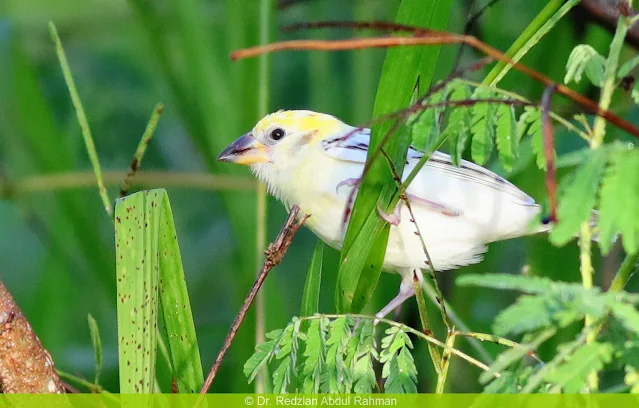The Baya Weaver
(Ploceus philippinus infortunatus) |
| Hello!, I am an England football supporter ;) |
Almost all parts of the body are white in colour, except for the yellow crown and part of the wings remain in black/brown colours.
 |
| Leucistic Baya Weaver (Ploceus philippinus infortunatus) - 2022-12-11 08:03:03.095 |
 |
Male Leucistic Baya Weaver - 10:12:2022 - 7:40am
|
While jogging around my housing area, I noticed a flock of birds that looked like sparrows/munia foraging on the grass. I saw a bird with a white feather, which was very unusual. I dashed home to get the camera. By the time I arrived, the birds were very far away.
 |
| Leucistic Baya Weaver |
The following three mornings (8 to 10 December 2022), I wait in the meadow for the weavers that usually eat the seeds. |
| Foraging on the thorny Giant sensitive tree (Mimosa pigra) |
|
 |
| 8:12:2022 - 7:42am |
 |
| Leucistic Baya Weaver, the head is yellow (male) - 7:12:2022 at 7:52am |
 |
| Male Leucistic Baya Weaver preening on the White Leadtree 9:12:2022 - 8:01am |
 |
| Feeding on the savanna grass (Axonopus compressus) seed 9:12:2022 - 7:56am |
Leucistic bird
In leucistic birds, affected plumage lacks melanin pigment due to the cells responsible for melanin production being absent. This results in white feathers unless the normal plumage colour also comprises carotenoids (e.g. yellows), which remain unaffected by the condition.
(info from Google)
Observations on Partial Albinism in Baya Weaver (Ploceus philippinus)
How rare is a leucistic bird?
Only 236 of the 5.5 million birds reported each year had leucism or albinism, making up a tiny proportion of birds with abnormal plumages. In other words, only about 1 bird in 30,000 has leucistic or albinistic plumage. Based on these results, leucism and albinism are very rare occurrences among birds.
(from Google)
 |
| Leucistic Baya Weaver (Male) in full breeding plumage. Pic by: Sushant Jadhav, from Facebook Indian Birds |
The picture below is of normal colours birds.
 |
| Male Baya Weaver |













No comments:
Post a Comment